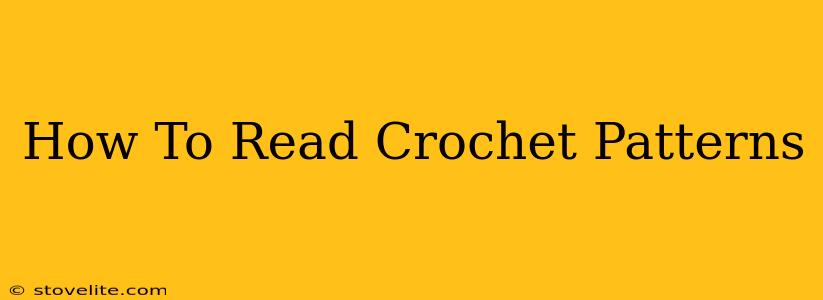So, you're ready to tackle that gorgeous crochet project you've been eyeing? Fantastic! But before you dive into the yarn, you'll need to understand how to read crochet patterns. Don't worry, it might seem daunting at first, but with a little practice, reading crochet patterns will become second nature. This guide will break down the essentials, turning those cryptic symbols into beautiful stitches.
Understanding the Basics of Crochet Pattern Symbols
Crochet patterns use a combination of text and symbols to describe the stitches and the overall construction of the project. Familiarizing yourself with these symbols is the first step to success. You'll usually find a key at the beginning of the pattern explaining each symbol, but here are some of the most common ones:
- ch: chain
- sc: single crochet
- dc: double crochet
- hdc: half double crochet
- tr: treble crochet
- sl st: slip stitch
These abbreviations are universally used, making it easier to follow patterns from various designers. However, always check the pattern's key to confirm the meaning of any symbols.
Understanding Pattern Structure
Most crochet patterns follow a consistent structure, typically including:
-
Materials List: This section lists the necessary yarn weight, type, color(s), hook size, and any other tools (like stitch markers or scissors). Paying close attention to this section is crucial for success. Using the wrong hook size or yarn weight can significantly affect the final product.
-
Gauge: Gauge refers to the number of stitches and rows per inch (or centimeter). This is essential to ensure your finished project matches the pattern's intended size. Always swatch! A swatch is a small sample of your work, allowing you to check your gauge before starting the main project. This saves you from having to redo significant work later.
-
Abbreviations & Symbols: As mentioned before, this key provides the meaning of all symbols and abbreviations used in the pattern.
-
Pattern Instructions: This is the main part of the pattern, providing detailed instructions on how to create the project. Instructions often use terms like:
- Round: For working in the round (typically for hats or amigurumi).
- Row: For working back and forth in rows.
- Repeat: Instructions to repeat a specific sequence of stitches.
- Increase: Adding stitches.
- Decrease: Removing stitches.
-
Finishing Instructions: This section details how to weave in loose ends, block (wet-block or steam-block) your project for even shaping (essential!), and add any finishing touches.
Deciphering Crochet Pattern Instructions: A Step-by-Step Guide
Let's look at a sample pattern instruction:
"Row 1: Ch 3 (counts as a dc), dc in 2nd ch from hook, dc in each ch across; repeat from * to * across."
Here's how to break it down:
- "Row 1:" This indicates the first row of the pattern.
- "Ch 3 (counts as a dc):" You chain 3 stitches, and these 3 chains count as one double crochet stitch.
- "dc in 2nd ch from hook:" Make a double crochet stitch in the second chain from your hook.
- "dc in each ch across:" Make a double crochet in each remaining chain across the row.
- "repeat from * to * across:" Repeat the instructions between the asterisks until the end of the row.
Tips for Success
- Start with easy patterns: Begin with simple projects to build your confidence and understanding of pattern instructions.
- Read the entire pattern before you start: This will give you a clear overview of the project and help identify potential challenges.
- Don't be afraid to ask for help: Join online crochet communities or seek assistance from experienced crocheters.
- Take your time: Crochet is a relaxing craft; enjoy the process!
Reading crochet patterns is a skill that develops with practice. By understanding the basic symbols, pattern structure, and taking things one step at a time, you'll soon be creating beautiful projects from your favorite patterns. Happy crocheting!

